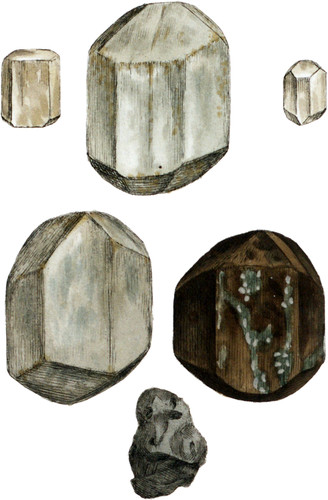 Enlarge
Enlarge
Exotic Mineralogy
Borax
- Syn.
- Borax and Tincal. Kirwan 2. 37.
- Soude boratée. Haüy 2. 336. Tabl. 20. Lucas, pt. 2. p. 88.
- Borate de Soude, Borax. Bourn. Catal. 193.
- Baurach of the Arabs. Tinckal of the Indians.
This useful salt has been imported from the East for the use of metallurgists and Jewellers for a long time, and yet its natural situation in the earth was unknown to Europeans until the latter part of the last century. The first correct account of it is given in the 2d volume of the Annales de Chimie, p. 299; where M. Saunders states, that it is dug from the sides of a lake, 15 days journey N.W. of Tissoolembo in Thibet: this lake is 20 miles in circumference; its waters are nearly at the same level at all seasons: it has no river running from it, but has several salt springs that supply the evaporation: it is frozen over during a great part of the year, so as to prevent the workmen from obtaining the salt. The nature of the rocks that surround the lake we are not acquainted with; but the springs from them contain much Muriate of Soda besides Borax. It is probably the constant evaporation of the water of these spring’s from the surface of the lake, that causes the Borax to he deposited in its lied as last as the workmen can dig it. Several other lakes and low pieces of ground, that were formerly lakes, both in Thibet and Persia, afford abundance of Borax; it is collected in impure masses and imbedded crystals, which are preserved from efflorescing by a coat of soapy matter: it is sold in the Indian markets by the name of Tinckal. When purified it assumes the appellation of Borax, from its Arabic name. It occurs also in China, Ceylon, and Saxony. The mines of Viquintipa, those in the neighbourhood of Escapa. in Potosi, have furnished a considerable supply to the native Americans, who have used it to assist in smelting the ores of copper which arc abundant in that district: it is by them called Quemason, a term nearly synonimons with Flux.
Haüy describes the crystals as derived from a rectangular prism; while Bournon observes, that the base of the primitive is perhaps somewhat different from a right angle; and says, that the suite of crystals in his (now the King of France’s) collection is sufficient to demonstrate what the primitive is.
The large crystals before us are from Persia; one of them is not cleared from the crust of soap with which it was preserved. The small crystals are probably artificial; they are in the state in which they were imported from India.

